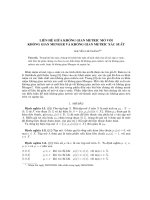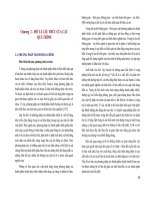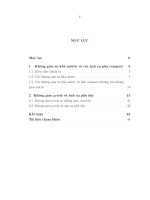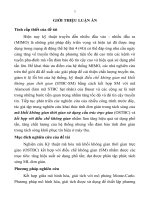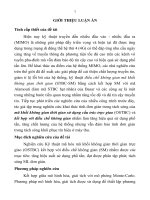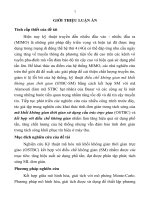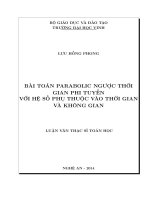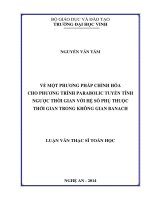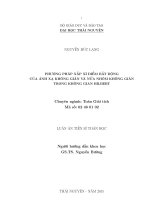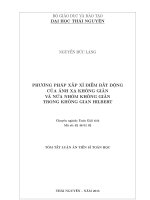NGHIÊN CỨU NGƯNG TỤ BOSE-EINSTEIN HAI THÀNH PHẦN TRONG KHÔNG GIAN BỊ HẠN CHẾ
Bạn đang xem bản rút gọn của tài liệu. Xem và tải ngay bản đầy đủ của tài liệu tại đây (451.64 KB, 6 trang )
<span class="text_page_counter">Trang 1</span><div class="page_container" data-page="1">
<b>THÔNG TIN VỀ LUẬN ÁN TIẾN SĨ </b>
1. Họ và tên nghiên cứu sinh: Hoàng Văn Quyết 2. Giới tính: Nam
4. Nơi sinh: Bắc Giang.
5. Quyết định công nhận nghiên cứu sinh: 993/QĐ-ĐHSPHN2
6. Các thay đổi trong quá trình đào tạo: Tên luận án và bổ sung người dẫn 2.
<b>7. Tên đề tài luận án: Nghiên cứu ngưng tụ Bose-Einstein hai thành phần trong không gian bị hạn chế. </b>
8. Chuyên ngành: Vật lý lý thuyết và Vật lý toán 9. Mã số: 9 44 01 03
10. Cán bộ hướng dẫn khoa học: 1. GS. TSKH Trần Hữu Phát 2. PGS. TS Nguyễn Văn Thụ 11. Tóm tắt các kết quả mới của luận án:
Các chế độ ripplon của hệ ngưng tụ Bose-Einstein (BEC) hai thành phần phân tách bị giới hạn bởi một và hai tường cứng (tường quang học) đã được chúng tôi nghiên cứu bằng phương pháp gần đúng hydrodynamic trong khuôn khổ lý thuyết Gross-Pitaevskii (GP) và đã thu được các kết quả sau: a) Khi hệ ở trạng thái đứng yên do sự hạn chế về không gian, hệ thức tán sắc ở giới hạn bước sóng dài trong cả hai trường hợp đều có dạng có dạng 𝜔~𝑘<sup>2</sup>. b) Khi hệ chuyển động song song với mặt phẳng phân cách, hệ thức tán sắc ở giới hạn bước sóng dài trong cả hai trường hợp đều có dạng 𝜔 ~ 𝑘 và hơn nữa hệ trở nên không ổn định.
Các hiệu ứng kích thước hữu hạn của hệ ngưng tụ Bose-Einstein (BEC) hai thành phần phân tách bị hạn chế bởi một tường cứng được nghiên cứu bằng hệ phương trình Gross-Pitaevskii trong gần đúng parabol kép (DPA). Từ sự nhất quán giữa các điều kiện biên (BC) trong hình cấu trúc hình học bị giới hạn và trong tồn bộ khơng gian, chúng tơi tìm thấy tất cả các trạng thái cơ bản của hệ và sức căng tại mặt phân cách tương ứng với các điều kiện biên. Từ đó, chúng tơi khám phá ra hai hiệu ứng kích thước hữu hạn: a) Trạng thái cơ bản của hệ ứng với điều kiện biên Neumann là ổn định trong khi trạng thái cơ bản ứng với điều kiện biên Robin và Dirichlet thì khơng ổn định. b) Có hai loại chuyển pha ướt bắt nguồn từ hai trạng thái không ổn định ứng với điều kiện biên Robin và
</div><span class="text_page_counter">Trang 2</span><div class="page_container" data-page="2">Dirichlet. Tuy nhiên, loại chuyển pha ướt ứng với điều kiện Robin được ưu tiên hơn vì nó tương ứng với năng lượng nhỏ hơn.
Hiệu ứng Casimir-like trong hệ ngưng tụ Bose-Einstein (BEC) hai thành phần phân tách bị hạn chế bởi hai tường cứng được nghiên cứu bằng phương pháp gần đúng parabol kép trong khuôn khổ lý thuyết Gross Pitaevskii. Sau khi xác định các điều kiện biên (BC) tại các bức tường cứng, chúng tơi đã thu được các biểu thức giải tích của hàm sóng của hai thành phần ngưng tụ và sức căng tại mặt phân cách tương ứng với các điều kiện biên Neumann, Robin và Dirichle. Từ đó, chúng tơi phát hiện ra hai hiệu ứng kích thước hữu hạn có liên quan mật thiết với sức căng tại mặt phân cách: a) Bên cạnh lực Casimir thơng thường thì trong hệ BEC bị giới hạn bởi hai tường cứng xuất hiện loại lực tương tác tầm xa có những đặc điểm tương tự như lực Casimir, gọi là các lực Casimir-like. b) Hiệu ứng kích thước hữu hạn thứ hai liên quan trực tiếp đến các điều kiện biên, đó là trạng thái cơ bản của hệ ứng với điều kiện biên Neumann là ổn định trong khi trạng thái cơ bản ứng với điều kiện biên Robin và Dirichlet thì khơng ổn định. Do đó, lực Casimir-like ứng với điều kiện Neumann vượt trội hơn các lực Casimir-like ứng với các điều kiện biên khác. 12. Khả năng ứng dụng thực tiễn: Các kết quả của luận án là những đóng góp có ý nghĩa cho hướng nghiên cứu về các hiệu ứng không gian bị giới hạn (finite – size effects). 13. Các hướng nghiên cứu tiếp theo: Bên cạnh các kết quả đã đạt trong luận án, chúng tôi kiến nghị áp dụng các phương pháp đã sử dụng trong luận án nghiên cứu hai vấn đề sau đây:
- Ảnh hưởng của nhiệt độ tới các tính chất tĩnh của hệ ngưng tụ và hiện tượng chuyển pha ướt.
- Hiệu ứng Casimir trong hệ BEC hai thành phần bị giới hạn bởi các tường cứng với điều kiện biên Robin.
14. Các cơng trình cơng bố liên quan đến luận án:
<i>[1] Hoang Van Quyet, Nguyen Van Thu, Dinh Thanh Tam, Tran Huu Phat, On the </i>
<i>finite-size effects in two segregated Bose-Einstein condensates restricted by a hard wall, </i>
<b>Condensed Matter Physics Vol. 22, No. 1, 13001 (2019). </b>
<i>[2] Hoang Van Quyet, Dinh Thanh Tam, Tran Huu Phat, On the Casimir - like </i>
<i>effect in system of two segregated Bose-Einstein condensates restricted by two hard walls, </i>
<b>Journal of Low Temperature Physics, Volume 196, Issue 5–6, pp 473–493 (2019). </b>
</div><span class="text_page_counter">Trang 3</span><div class="page_container" data-page="3"><i>[3] Tran Huu Phat, Hoang Van Quyet, Ripplon modes of two segregated </i>
<i><b>Bose-Einstein condensates in confined geometry, Communications in Physics Vol. 26, 1, </b></i>
(2016).
<i>[4] Nguyen Van Thu, Hoang Van Quyet, Antonov wetting line phase transition of </i>
<i>two-component bose-einstein condensates under constraint of robin boundary condition, </i>
<b>Dalat University journal of science Volume 8, Issue 3, 61–68 (2018). </b>
<i>[5] Hoang Van Quyet, Phan Thi Oanh, Location of interface Bose-Einstein </i>
<i>condensate mixtures in semi-infinite space under robin boundary condition, Journal of </i>
<b>Science (HPU2) 50, 71 (2017). </b>
<i>[6] Hoang Van Quyet, Tran Huu Phat, Nambu-Goldstone modes of two immiscible </i>
<i>bose-einstein condensates limited by one soft wall, Đăng toàn văn trong kỷ yếu Hội thảo </i>
khoa học cán bộ trẻ các trường Đại học sư phạm toàn quốc lần thứ (2015).
</div><span class="text_page_counter">Trang 4</span><div class="page_container" data-page="4"><b>INFORMATION ON DOCTORAL THESIS </b>
1. Full name: Hoang Van Quyet 2. Sex: Male
3. Date of birth:10/8/1983 4. Place of birth: Bac Giang
5. Admission decision number: 993/QĐ-ĐHSPHN2
6. Changes in academic process: Thesis title and add the supervisors 2
<b>7. Official thesis title: Research of two-component Bose – Einstein condensates in limited space. </b>
8. Major: Theoretical and computational physics. 9. Code: 9 44 01 03
10. Supervisors: Scientific Supervisor 1: Prof.Dr Sci Tran Huu Phat.
Scientific Supervisor 2: Assoc.Prof. Dr. Nguyen Van Thu. 11. Summary of the new findings of the thesis:
The ripplon modes of two segregated Bose-Einstein condensates (BECs) confined by one and two hard walls are respectively studied by means of the hydrodynamic approach within the Gross-Pitaevskii (GP) theory. For the system at rest we find that due to the spatial restriction the dispersion relations are of the form 𝜔~𝑘<sup>2</sup>, in low momentum limit for both cases, while for the system in motion parallel to the interface the dispersion relations for both cases are 𝜔~𝑘, at low momentum limit and, furthermore, the system becomes unstable.
The finite-size effects in two segregated Bose-Einstein condensates (BECs) restricted by a hard wall is studied by means of the Gross-Pitaevskii equations in the double-parabola approximation (DPA). Starting from the consistency between the boundary conditions (BCs) imposed on condensates in confined geometry and in the full space, we find all possible BCs together with the corresponding condensate profiles and interface tensions. We discover two finite-size effects: a) The ground state derived from the Neumann BC is stable whereas the ground states derived from the Robin and Dirichlet BCs are unstable. b) Thereby, there equally manifest two possible wetting phase
</div><span class="text_page_counter">Trang 5</span><div class="page_container" data-page="5">transitions originating from two unstable states. However, the one associated with the Robin BC is more favourable because it corresponds to a smaller interface tension. The Casimir-like effect in the system of two segregated Bose–Einstein condensates restricted by two hard walls (optical walls) is studied by means of the Gross–Pitaevskii theory in the double-parabola approximation. After determining the boundary conditions (BCs) at hard walls, we obtain the analytical expressions for both condensates and the interface tensions corresponding, respectively, to the Neumann, Robin and Dirichlet BCs. We discover two finite-size effects which closely connect with interface tensions: a) Beside the conventional Casimir force caused by the zero-point energy there still emerges in the system a new type of long-range forces associated with different interface tensions. They are called the Casimir-like forces. b) The second finite-size effect is directly associated with the BCs, it claims that the Neumann BC leads to stable state while the two other BCs provide unstable states of the underlying system. Therefore, the Casimir-like force derived from the Neumann BC is the dominant one in the system since it is present in the stable state.
12. Paratical applicability, if any: The results presented in this thesis are meaningful contributions for studying of finite-size effects.
13. Further research directions, if any: Besides the results achieved in the thesis, we propose to apply the methods used in the thesis to study the following two issues:
- The influence of temperature on static properties of condensate systems and the phenomenon of transition wetting phase.
- The Casimir effect in the two-component BEC system that is limited by hard walls with Robin boundary conditions.
14. Thesis-related publications:
<i>[1] Hoang Van Quyet, Nguyen Van Thu, Dinh Thanh Tam, Tran Huu Phat, On the </i>
<i>finite-size effects in two segregated Bose-Einstein condensates restricted by a hard wall, </i>
<b>Condensed Matter Physics Vol. 22, No. 1, 13001 (2019). </b>
<i>[2] Hoang Van Quyet, Dinh Thanh Tam, Tran Huu Phat, On the Casimir - like </i>
<i>effect in system of two segregated Bose-Einstein condensates restricted by two hard walls, </i>
<b>Journal of Low Temperature Physics, Volume 196, Issue 5–6, pp 473–493 (2019). </b>
<i>[3] Tran Huu Phat, Hoang Van Quyet, Ripplon modes of two segregated </i>
</div><span class="text_page_counter">Trang 6</span><div class="page_container" data-page="6"><i><b>Bose-Einstein condensates in confined geometry, Communications in Physics Vol. 26, 1, </b></i>
(2016).
<i>[4] Nguyen Van Thu, Hoang Van Quyet, Antonov wetting line phase transition of </i>
<i>two-component bose-einstein condensates under constraint of robin boundary condition, </i>
<b>Dalat University journal of science Volume 8, Issue 3, 61–68 (2018). </b>
<i>[5] Hoang Van Quyet, Phan Thi Oanh, Location of interface Bose-Einstein </i>
<i>condensate mixtures in semi-infinite space under robin boundary condition, Journal of </i>
<b>Science (HPU2) 50, 71 (2017). </b>
<i>[6] Hoang Van Quyet, Tran Huu Phat, Nambu-Goldstone modes of two </i>
<i>immiscible bose-einstein condensates limited by one soft wall, Conference for young </i>
lecturers of 5th National Pedagogical Universities (2015).
Date: August 15, 2019
<b> Supervisor Supervisor 1 Supervisor 2 PhD Student </b>
Prof. Dr Sci Tran Huu Phat Assoc. Prof. Dr. Nguyen Van Thu Hoang Van Quyet
</div>